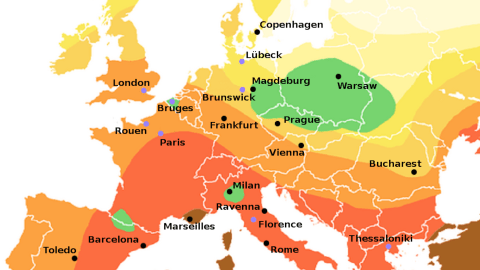Why did the Plague spare Poland?

Image: Andy85719 - CC BY-SA 3.0
- Calm down, we’re not comparing COVID-19 to the Plague.
- Well, not literally. But this map raises an interesting question: Why were some parts of Europe spared of the Black Death?
- And can that tell us something about modern pandemics?

Engraving of ‘Doctor Schnabel’ (‘Dr. Beak’), a plague doctor in 17th-century Rome, wearing the typical mask with which caregivers sought to keep the ‘bad air’ at bay that they held responsible for the spread of the disease.
Image: Paulus Fürst, ca. 1656 – public domain
The doctor will see you now
The Black Death was a ruthless killer – and, if you were lucky, a swift one. Its more fortunate victims “ate lunch with their friends, and dinner with their ancestors in paradise,” wrote Giovanni Boccaccio, who lived through the initial wave of the Plague as it struck Italy in the 1340s.
What does that have to do with the coronavirus? Not a whole lot, fortunately. Except that the brief of this little corner of the internet is to look for strange maps, and one map led to another.
The Plague was brought from China to Europe in the 1330s by rodents hitching rides with traders. The infection with the Yersinia pestis bacterium was typically transmitted to humans by fleabites. The Plague’s three manifestations were bubonic (causing painful swellings), septicemic (infecting the bloodstream) and pneumonic (choking off breathing, and transmittable via coughing). Left untreated – as was necessarily the case in the Middle Ages – bubonic plague had a mortality rate of about 50%, for the other two, it’s virtually 100%.
Bocaccio’s Italy was hit hard by the epidemic. Cities like Venice and Pisa lost three-quarters of their population. The disease followed the traditional trading routes north, racing forward each spring as a new generation of fleas was ready to spread the infection.
The Plague afflicted most of Europe in a relatively brief period. It’s estimated that it killed as many as 25 million – a third of Europe’s population at the time – in just five short years.
Absent explanations and remedies, Europe’s populations turned to God for hope, and victimized outsider groups as scapegoats. Some of Western Europe’s worst anti-Jewish pogroms before WWII took place during outbreaks of the Plague.

In just a few years, the Plague had moved from its entry points on the Mediterranean as far north as Scandinavia.
Image: Andy85719 – CC BY-SA 3.0
Plague’s progress
This map shows the progress of the Plague, from its arrival in the Mediterranean:
- First afflicted (in 1347) were Asia Minor, and the islands of Sicily, Sardinia and Corsica, with just small bridgeheads on the European mainland: Marseilles and environs, Calabria (the tip of Italy’s shoe), and the southern shore of what is now Turkish Thrace (i.e. European Turkey).
- By the next year (1348), the disease had achieved a firm foothold in Europe, reaching as far as the gates of Toledo and Paris.
- In early 1349, the Plague had overwhelmed London and Frankfurt, and was poised to pounce Vienna and Bucharest. Later that year, it reached as far as Ireland and Norway.
- Its relentless march north continued. In 1350, it hit Lübeck and Copenhagen, reaching high into Norway. In 1351 and thereafter, it swept further north, touching the entire continent.
The Black Death has left deep traces in European history. To this day, ødegård – ‘deserted farm’ – is a fairly common place name in Norway, to name just one example.
But as this map indicates, the Plague spared certain areas (marked green on the map) on march of destruction:
- an area in Italy centered on Milan;
- small, contiguous parts of Spain and France, on either side of the Pyrenees;
- an area in the Low Countries around Bruges;
- a large area in Eastern Europe, stretching from Magdeburg to beyond Warsaw, taking in most of present-day Poland, plus some surrounding areas.
Why? First off, the map is slightly misleading. Green does not mean ‘safe’, just ‘less deadly’. Milan, for example, only lost about 15% of its population. Horrific by today’s standards, but a mere trifle compared to the almost wholesale extinction of Italy’s other cities. In Poland and the other ‘green’ areas too, people did die of the Plague, albeit in much lower numbers than elsewhere.
Blues vs. Greys
One main reason why Poland escaped relatively unscathed, was the decision by Poland’s king, Casimir the Great, to close the country’s borders – and set up internal quarantines.
This increased Poland’s natural isolation, both from the outside world and between the settlements within the country – generally smaller and less connected than elsewhere in Europe. Prague to Krakow took eight days on horseback. People infected took between 24 to 72 hours to get sick. So the issue would ‘resolve’ itself well before the danger reached the Polish border.
Isolation plus quarantine certainly helped spare Poland from the worst of the epidemic. One more spurious explanation is that Poland had more cats than other parts of Europe, and thus less disease-carrying rats…
Milan’s significantly lower mortality rate may also be down to the city’s stricter quarantine measures: The houses of infected families were simply bricked up (with the infected left to die inside).
Like Poland, the French-Spanish area, corresponding to the then-kingdom of Navarre, may have benefited from its relative isolation. Why the area around Bruges – then a thriving port with connections to the Mediterranean – might have been spared, is more of a mystery.
So, what’s the lesson, if any? Isolation definitely helps against infectious diseases. But that’s about the only advantage of being isolated. Take this map of the spread of COVID-19 as of 11 am on 5 March. If you had to divide the world into ‘fun’ and ‘no fun’ halves, they would correspond quite well with the blue and grey zones on this map, respectively.
For example, one sure-fire way to limit your exposure to the outside world is to have a bloody civil war – see Yemen, Libya and Syria. Another is to be a destination as out of the way and unconnected as Paraguay, the Central African Republic or Mongolia.
If it’s the price of living in an interconnected world, then perhaps there are worse things than having to fight off a slightly deadlier iteration of the flu. Praise globalization and pass the hand sanitizer – with your elbows, please!
Strange Maps #1014
Got a strange map? Let me know at strangemaps@gmail.com.






